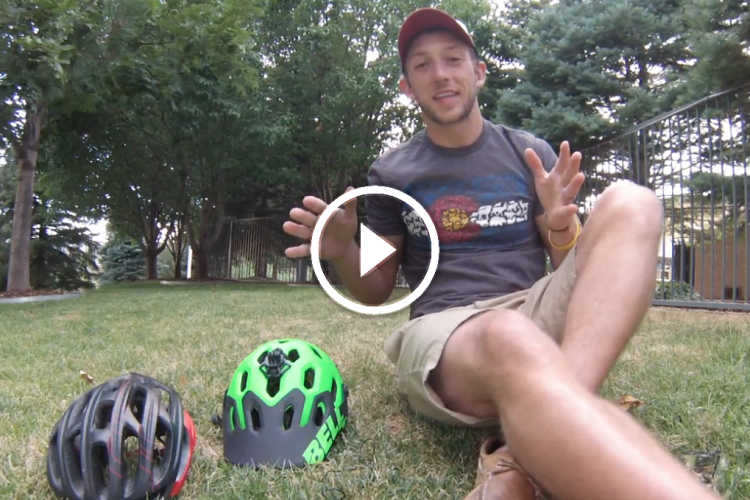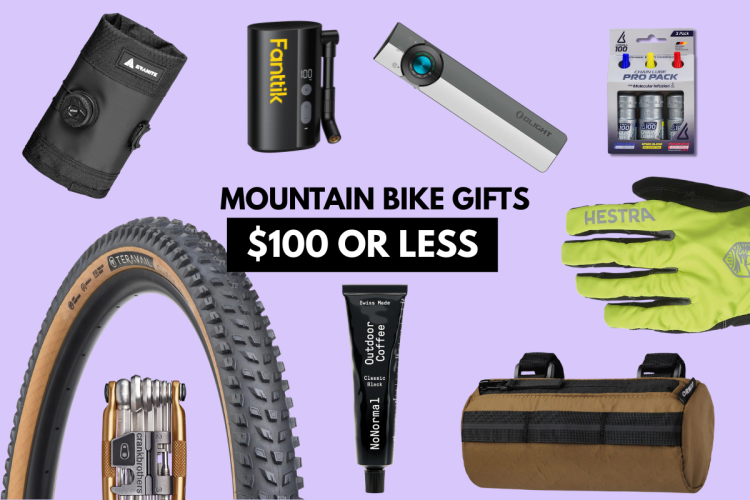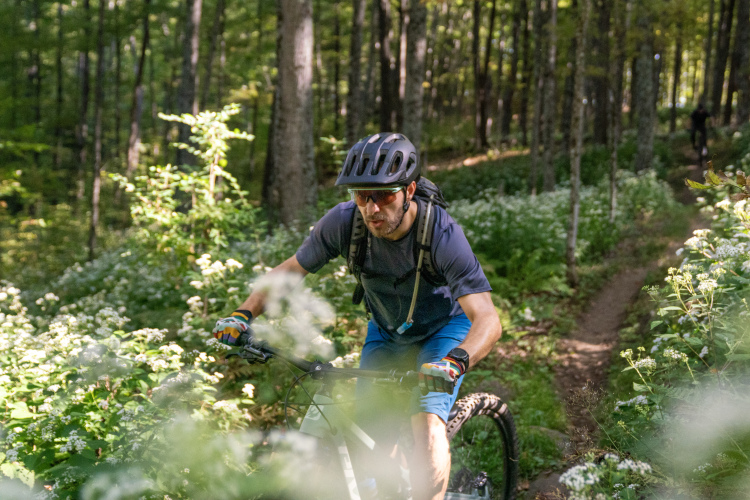
Riders my age might remember seeing “No Fear” t-shirts. They had great motivational sayings, and conveyed the message that you could erase fear from your life. Ask any mountain biker and they will tell you there is no such thing as being fearless. As Laird Hamilton put it, “if you aren’t able to be scared, you either haven’t been hurt or you’re completely ignorant.”
Fear is a part of our DNA. It helps keep us alive. However, if left unchecked, fear can prevent us from reaching our full potential as riders. I have struggled with fear ever since I started mountain biking. I have not yet conquered it, but I have learned three things that can help control fear.
Determine the source of your fear

For me, my biggest fear when it comes to mountain biking is on descents and stems from two over-the-bars crashes I’ve had while descending. Those two crashes made me afraid to descend, and it has taken a while to overcome the fear of descending on a mountain bike. For others, it could be going through a rock garden, or riding over a wooden feature. Whatever the case may be, you must first pinpoint the source of your fear before you can learn how to control it.
Learn how to be a better rider
If you fear particular trail features, the best way to control that fear is by learning and mastering the fundamentals of mountain biking. Knowing how to balance yourself on a bike while climbing, descending, and cornering will give you the confidence you need to counteract your fear. I don’t dread tackling a particular trail feature when I know exactly what it will feel like when I ride over it, and how my bike will react to it.
Additionally, you need to know how to properly set up your bike, i.e., suspension, tire pressure, and saddle height, so that it performs at its best. You can’t learn these fundamentals overnight. I have spent a lot of time reading articles, watching videos, practicing basic skills, and taking notes on what tire pressures and shock pressures I used on different trails in different conditions. I still have a ways to go, but the knowledge I have gained so far has given me confidence, which helps me better control my fear.
Conquer fear one small step at a time



I wish I could knock out all my fear in one swift stroke, but I can’t. Instead, I have gradually gained control over my fears through a series of small victories. Recently, I mastered a rocky descent that I had been afraid to ride down. I did it over the course of a few months in small steps.
I started by walking down it all the way. Each time I did, I studied the section, looking for possible lines. Next, I walked down part of the way and then tried riding down the rest of the way. That gave me a feel for how my bike would react to it, and I got to test out a couple of different lines. Finally, I followed my more experienced riding partner down it from the very top, making sure I rode exactly where he did. I made it down without incident, and we celebrated the victory together. Moments like that will do wonders for your confidence, and help you control your fear so that you are willing to tackle other obstacles.
You’ll never eliminate fear but you can control it

Fear will always be a part of mountain biking because it is a risky sport. Riders can get seriously injured. However, if you love mountain biking like I do, you learn to accept the risks and enjoy the rewards. I love continually pushing myself physically and mentally. Yes, I am afraid at times, and there are some trail features I will not attempt, but little by little I am gaining control over my fear and becoming a better rider.
How do you control your fear when riding? Please feel free to share in the comments section below.











23 Comments
Aug 14, 2019
Aug 14, 2019
Someday I am going to work up to them. Maybe on a different bike. I know they are doable as I have either seen photographic evidence or tire tracks in the snow.
This year I have been working on several things to build up to those including: fitness, balance and technical climbing. Honestly, I am beyond shocked at what I can climb even compared to earlier this spring. Progress sure does feel good.
Aug 14, 2019
Aug 14, 2019
- unless you are following a rider you trust and whose skills are comparable don't blindly take on an obstacle or drop if you don't know the line or what's on the other side. Take the time to stop, inspect, and determine a line.
- learn and practice your technique on the easier stuff and feel comfortable doing that before tackling more challenging features.
-Youtube videos are a great tool but you need to video yourself so you can see what your are actually doing.
- if you can avoid it, don't take on the higher risk sections at the very beginning of your ride. You want to be warmed up. And also, some days you just may not "have it". That's the day you take the ride around or walk.
- don't take on the higher risk sections at the end of a ride if you're spent. Fatigue plays a huge role in how we perform. What's doable when you're feeling good and fresh may not be when you're physically and mentally exhausted. Don't be afraid to pass when your body and mind are not in the right place.
- wear protection. In many ways, knee and elbow pads (and even body armor) can help ease your mind. It's rare that you'll probably really need them but their use could help put you in a better (more confident) frame of mind
- use flat pedals. Not only will it force you to improve your technique but the extra split second or two you get from not having to unclip can be the difference between going down vs getting a foot down.
- weigh the risk vs the reward. It's this last one I can't recommend highly enough. If you're looking at something with very little risk then you should probably go ahead and give it a try. The more you do, the more you learn, the more confident you become, the better rider you will be. But if you're looking at doing something you don't have a lot of experience doing, like a huge drop or a large double where the consequences of failure can lead to serious injury you need to ask yourself "is the reward of doing it worth the risk if you fail?"
Aug 15, 2019
Aug 15, 2019
However, I am going to disagree on one issue, which is the age-old "flats vs clips" controversy. I rode flats when I first started mountain biking but I think (at the behest of son-in-law) when I switched to riding clipped in I became a better and faster rider. Maybe it's concentration knowing that I don't have that extra second you mention or maybe it is simply staying in better contact with the bike and it feels more like a "part of me" is the key.
Anyway, I really like road cycling and I do it every week but I really love mountain biking and ride as often as i can.
Aug 15, 2019
Don’t ride your bike downhill at break neck speeds. Keep your tires on the ground where they belong and you should be just fine.
Aug 15, 2019
Aug 15, 2019
+1
Aug 15, 2019
Aug 26, 2019
With a wife and kids that depend on me, my fear always came out of the catastrophic "what if..." scenario. I had to be smart in my progression, while still pushing myself a little harder each time out.
And @kangaldog ...some people like to conquer their fears of getting tires off the ground. I'm one of the ones who likes keeping the tires on the dirt, but a little airtime every now and again is good for the soul.
Aug 27, 2019
Aug 15, 2019
Aug 17, 2019
Aug 15, 2019
Dec 6, 2019
Small steps and keeps practicing are great advice. Thanks G.
Aug 15, 2019
Aug 15, 2019
Aug 15, 2019
I also use a GoPro a lot. Not to brag to the world, but to see where i had unnecessary fear. Sometimes, I even surprise myself that I've done better than I thought.
Aug 15, 2019
Dec 6, 2019
Aug 17, 2019
Would you ride a formula 1 full speed on your first day? Probably not.
The technique is everything in the building of your confidence. And, It will also keep you safe.
Now the question is more, how do you consistently improve your technique and do you measure it?
That's what I'm obsessed with these days. A go-pro helps but it is not all.
Any tips on this?
Aug 18, 2019